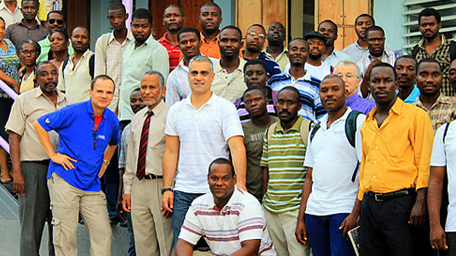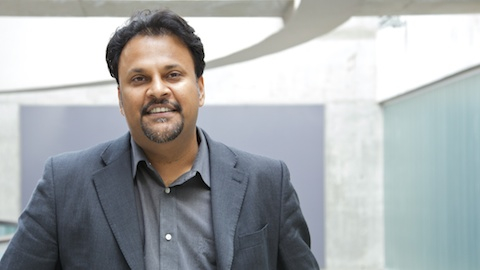
University of Toronto Engineering Professor Constantin Christopoulos (CivE) traveled to Haiti to join international instructors in delivering a two-day short course as part of a three-week earthquake engineering seminar in August.
There is perhaps no place where the lessons were more needed and nowhere were it was more difficult to deliver. On January 12, 2010, more than 316,000 people died due to a 7.0 earthquake that devastated the Caribbean nation.
The destruction that occurred in Haiti left the nation’s universities in ruins. With teaching spaces, labs and libraries destroyed, and faculty members among the killed or injured, help from abroad is needed to deliver the lessons Haiti’s engineering community requires.
“I responded to an international call seeking French-speaking experts in the field,” explains Professor Christopoulos, whose research focuses on structural dynamics and earthquake engineering.
The program was organized by MCEER at the University at Buffalo, State University of New York and hosted by l’Université Quisqueya in Haiti.
Professor Chistopoulos’ seminar focused on making steel structures more resistant to earthquakes.
“What occurred in Haiti was not simply an act of God. It was definitely an extreme natural event but its impact on structures could have been limited and catastrophic collapses could have been prevented,” Professor Chistopoulos explains.
More than 130 participants attended the seminar, which included current engineering students, local experts and members of the Haitian Ministry of Public Works. Planning has begun on establishing a new Master’s degree in earthquake engineering at the l’Université Quisqueya, which would be delivered by a team of instructors from other international institutions.
As Haiti is being rebuilt, Professor Chistopoulos notes that incorporating the latest earthquake resistant technology will be necessary to ensure the failures of 2010 are not repeated.
“Haiti had no building codes. Given our experience and expertise here in Canada, we can provide assistance and guidance,” he says, though he points out that it is not possible to just hand over advanced building design guidelines and expect that it would be fully implemented. “We will have to work with Haitian officials to tailor the code to be practically applied to their building environment.”
Prior to his trip in August, Professor Christopoulos’ only connection to Haiti was growing up in Montreal surrounded by its large Haitian expatriate community. However, he intends to remain involved by developing course options andresearching how earthquake resistant technology can be applied in Haiti.

University of Toronto Engineering Professor Prasanth Nair (UTIAS) has been awarded the Canada Research Chair (CRC) in Computational Modeling and Design Optimization Under Uncertainty .
The prestigious honour recognizes Professor Nair’s research excellence, which involves developing the next generation of computational methods for improving the performance and safety of complex engineering systems.
His work will concentrate on ways to reduce the time and money it takes to run select systems that often do not perform the same way in theory as they do in the real world.
To address this challenge, he will “focus on developing new mathematical frameworks and methods for computational modeling in the presence of uncertainty,” he explained. “This work will ultimately be used to design systems that perform as intended – saving time and money and making engineered systems safer.”
Professor Nair, who joined the University of Toronto Institute of Aerospace Studies (UTIAS) in March 2011, is also excited that his research will take place at U of T Engineering where he’ll work with top peers and world-class computational infrastructure. “The Institute for Aerospace Studies, where I am based, is one of the top aerospace departments in the world, which attracts some of the best undergraduate and graduate students from Canada and across the world.”
Before being recruited to work at the University of Toronto, Professor Nair was appointed as a Research Fellow in the School of Engineering Sciences at the University of Southampton in England, later being promoted to Senior Lecturer.
Canada Research Chairs are divided into two tiers. Professor Nair was named a Tier II Chair, which recognizes recipients who are emerging research leaders in their fields. They are also awarded $500,000 over five years and may be renewed once at the discretion of their university.
“We are extremely grateful and proud that Professor Prasanth Nair has been awarded the Canada Research Chair,” said Professor Cristina Amon, Dean of the Faculty of Applied Science & Engineering. “This recognition attests to the high quality of Professor Nair’s research and his potential to become a leader in the field of computational modeling and design optimization.”
The Canada Research Chair program is a government-funded initiative, which was launched in 2000. It is part of a national strategy to recognize research excellence and attract first-class researchers from around the world to Canadian universities.
To learn more about all the new U of T CRC Chairs, visit U of T News.
Groundbreaking research by Professor Milos Popovic (IBBME) to restore movement in the hands of quadriplegic patients is featured in today’s The Globe & Mail.
Professor Popovic’s treatment focuses on functional electrical stimulation, in which electrical pulses are used to contract muscles in the patient’s body. This allows a patient to grasp things with his or her hand. Over the course of repeated treatments, the patient’s nervous system can be retrained so that he or she can eventually grasp items without using the electrical stimulation.
The experimental treatment is currently being studied through a national clinical trial being led by Professor Popovic and which is being funded through the Rick Hansen Institute.
Professor Popovic is a Core Professor in the Institute of Biomaterials and Biomedical Engineering and the Toronto Rehab Chair in Spinal Cord Injury Research at the Toronto Rehabilitation Institute.
Read the story to learn more about Professor Popovic’s work.
Professor Emeritus John Senders (MIE) is among a number of U of T professors who took home a 2011 Ig Nobel Prize for their “improbable research.”
The awards ceremony, which takes place at Harvard University, proves that research can be fun – and funny. Professor Senders won in the “public safety” category for “conducting a series of safety experiments in which a person drives an automobile on a major highway while a visor repeatedly flaps down over his face, blinding him,” as seen in this YouTube video from 1967. In it, he notes calmly that “the shorter the interval between looks, the more difficult that section of road is to drive,” as he speeds down a Boston highway with his view increasingly obscured.
For more information on Professor Sender’s research and other U of T winners, read the full article in Maclean’s.
The University of Toronto’s Human-Powered Vehicle Team placed third overall at the 2011 World Human-Powered Speed Challenge, held in Battle Mountain, Nevada.
The competition took place from September 12 to 17 on a flat and almost perfectly straight eight-kilometre stretch of highway in the Nevada desert.
The U of T team had a top speed of 117 km/h, which was a personal best for racer and PhD candidate Todd Reichert, who spent the last year cycling and speed skating, working with the Peak Centre for Human Performance, in Ottawa. He now boasts the title of ninth fastest human of all time.
He was joined on the road by fellow U of T racers Victor Ragusila, Trefor Evans and Aidan Muller, who all reached speeds in excess of 97km/h throughout the week.
The bike, named Vortex, was constructed by a team that included both undergraduate and graduate engineering students. The primary team members include Ragusila, Evans, Muller and Reichert, in addition to Marissa Goldsmith, Keith Hui, Alfie Tham, Rosemary Chiu and Vladislav Ternovsky.
The project gives students a chance to get hands on experience in engineering design as well as exposing them to leading-edge construction methods with carbon fibre and other space-age materials. To design a vehicle that can reach 117 km/hr on less than one horsepower requires a novel design approach.
“With a car, you can always get it to go faster by putting in a bigger engine,” says Reichert. “The starting point for a human-powered vehicle is one of limited resources in the form of a one horsepower engine. If you want to go faster, you have to be smarter. It’s a design philosophy that’s very important for today’s engineers.”
In addition to being designed for top speed, the bike is capable of carrying groceries, navigating tight turns and going over speed bumps. It was originally designed to race in the “Utility” class of the American Society of Mechanical Engineers Human-Powered Vehicle Challenge. The team scored first place out of a field of more than 30 universities in the 2011 Challenge.
The team has already started work on next year’s design, which they believe will be able to break the current land-speed record of 133.3 km/hr.
Read about the team’s success in the Toronto Star .
The U of T Human-Powered Vehicle Team is not the only group of engineers surpassing personal bests. See what the Blue Sky Solar Racing Team has built here.
An invention by Mechanical Engineering graduate Bradley Pierik (MechE 0T9) that brings clean water to the developing world is profiled in today’s The Globe & Mail.
Pierik invented a hand-held device that purifies unfiltered water by pressing it through a fibre membrane. The product is now sold through his company, Twothirds Water Inc., and is focused on providing drinkable water in developing nations.
To learn more about the invention and Pierik’s novel engineering solution to a pressing global challenge, click here.
